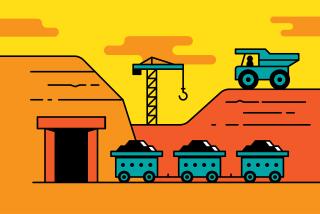Too Many Old Mines, Too Little Money
Federal and state officials have known for years that the abandoned Blue Light Mine in the Santa Ana Mountains was a potential deathtrap for curious explorers, but say they lacked the money and manpower to seal it.
Santa Ana brothers Nicholas, 23, and Glenn Anderson, 18, died in the flooded former silver mine Sunday, bringing to 13 the number of people who have been killed nationwide this year in old mines and quarries. Since the beginning of 1999, at least 55 people have died, most of them by drowning.
As they juggled grief and anger Tuesday, the Andersons’ friends and relatives began organizing a petition drive demanding that authorities seal the Blue Light Mine, and contemplated a vigilante-style visit to the area to do the job themselves.
“We need to do something as a community to make sure this doesn’t happen again,” said Julie Flanders, mother of Matthew Murphy, 17, who was hiking with the Andersons. “We put railroad guards over crossings; we should be putting bars over mine openings.”
Authorities said the deaths have led them to scour budgets to find money to seal the tunnel in which the brothers died, one of the mine’s eight openings that are accessible to the public.
“When you have a tragedy like this, it reminds you of potential hazards that may not have been on the front burner,” said Kathy Bacon, deputy public affairs officer for the Cleveland National Forest, which manages the 269-acre Blue Light Mine parcel. “The Forest Service will try to determine what sort of grating or obstructions could or should be done.”
Bacon said short-term measures have already been taken. Federal officials will be posted near the mine through the long Fourth of July weekend to warn daytime visitors of the dangers. The mine lies about two miles off Silverado Canyon Road, beyond a locked gate that prevents vehicles from entering the area.
“It’d be wonderful if we could make the Cleveland National Forest safe from all potential hazards, but we’ve got 427,000 acres to manage,” Bacon said. “We’ve got potentially dangerous roads, insects, animals, snakes and abandoned mines.”
Forest officials will also reevaluate the type and number of warning signs that should be posted near the unmarked mine, she said, though signs often are vandalized or stolen.
Autopsies conducted Tuesday were inconclusive. The Orange County coroner’s office said it will issue its rulings after toxicology tests--which could take more than a month--are completed. Officials said they believe the brothers suffocated in the foul air or drowned.
The Anderson brothers and Murphy entered a mine pool Sunday afternoon. Murphy, a certified diver, decided the opaque water was too dangerous to navigate and declined to follow the brothers any deeper into the cave.
“They got into about chest-deep water, and one of the boys felt an opening under the surface with his hands that led into the next cavern, and they just went in,” Flanders said.
“But Matt just couldn’t, wouldn’t go any farther. So he left his flashlight pointed toward the opening so the boys could see it from the other side. But none of them knew the air was full of carbon dioxide and methane gas.”
Murphy spent much of Tuesday with friends, his body still bearing amber stains from the murky mine pool, Flanders said.
“These kids want to grab as many boards and nails and hammers they can to close these mines off themselves,” she said.
There are more than 46,000 abandoned mines and quarries in California or about one every 3.4 square miles, according to state officials. Only a few are sealed each year under policies that focus on mines posing environmental risks, such as leaching poisons into watersheds.
Most of the more than 200 abandoned mines identified in the Cleveland National Forest remain accessible; last year officials plugged one mine that posed too much of a risk near Trabuco Canyon Road.
There are four general approaches to sealing mines: installing gates, filling vertical shafts with a hardening foam, backfilling with dirt and rock, and using dynamite to collapse tunnels. Costs vary by method, and some--such as dynamiting--carry heavy environmental risks, including endangering bats.
A year after a 1997 Forest Service study rated the Blue Light Mine as a high physical hazard, federal officials closed three of its most accessible openings with $7,000 gates, plus the costs of installation and delivery by helicopter. One expert said it would cost about $20,000 to fill the Blue Light Mine with foam. Estimates for dynamiting and backfilling were not available.
Sunday was the first time the Anderson brothers had visited the Blue Light Mine.
“I gave warnings to both [Matt and Glenn] before they left the house,” Flanders, Murphy’s mother, said Tuesday.
“I said, ‘If you go hiking up to Silverado, watch for rattlesnakes, and whatever you do, don’t go in the mines, and don’t go in the caves.’
“They just happened to take a different trail and happened upon [it],” she said. “But if there had been something warning them, a sign that said danger, methane gas or carbon dioxide, they never would have gone in there.”
*
Times staff writer Mike Anton contributed to this report.
More to Read
Sign up for Essential California
The most important California stories and recommendations in your inbox every morning.
You may occasionally receive promotional content from the Los Angeles Times.











